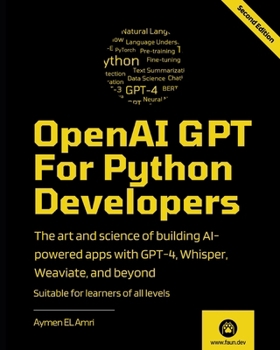OpenAI GPT For Python Developers - 2nd Edition: The art and science of building AI-powered apps with GPT-4, Whisper, Weaviate, and beyond
A Most Excellent Book Thomas Taylor
The knowledge you'll acquire from this guide will be applicable to the current families of GPT models and will likely also be relevant to GPT-5, should it ever be released.
By reading this guide and following the examples, you will be able to:
Understand the different models available, and how and when to use each one.Generate human-like text for various purposes, such as answering questions, creating content, and other creative uses.Control the creativity of GPT models and adopt the best practices to generate high-quality text.Transform and edit the text to perform translation, formatting, and other useful tasks.Optimize the performance of GPT models using various parameters and options such as max_tokens, temperature, top_p, n, stream, logprobs, stop, presence_penalty, frequency_penalty, best_of, and others.Stem, lemmatize, and reduce your costs when using the API.Understand Context Stuffing, chaining, and practice prompt engineering.Implement a chatbot with memory and context.Create prediction algorithms and zero-shot techniques and evaluate their accuracy.Understand, practice, and improve few-shot learning.Understand fine-tuning and leverage its power to create your own fine-tuned models.Implement fine-tuning best practicesPractice training and classification techniques using GPT.Understand embedding and how companies such as Tesla and Notion are using it.Understand and implement semantic search, RAG, and other advanced tools/concepts.Integrate a Vector Database (Weaviate) with your intelligent systems.Format:Paperback
Language:English
ISBN:B0CVQFWFFY
ISBN13:9798879612257
Release Date:February 2024
Publisher:Independently Published
Length:326 Pages
Weight:1.43 lbs.
Dimensions:0.7" x 8.0" x 10.0"
Customer Reviews
0 customer rating | 0 review
There are currently no reviews. Be the first to review this work.












